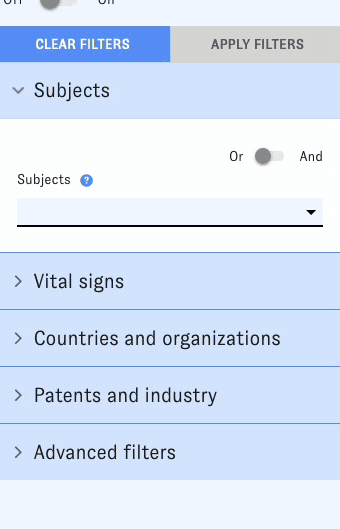Attention Substack users! ETO blog posts are also available on Substack.
ETO's Map of Science is great for uncovering critical pockets of research around the world. With the Map's flexible filters, it's easy to focus on areas of research with particular characteristics, such as topic, size, or relevant institutions.
As interdisciplinary research grows, combining filters in the Map can help you understand what's happening on the boundaries between research topics and how advances in one field are driving research in another. In our last post, we used the Map to explore especially hot areas of research in AI. Today, we'll use the same approach to survey the frontier between AI and biology research.
First, a quick refresher. The Map of Science organizes hundreds of millions of global research publications into research clusters, which are groups of articles that cite each other often - typically because they share other things in common, such as topics, concepts, or languages.
Map users often want to learn about the "top" areas of research on a particular subject. There could be many ways to define "top" research, of course, but ETO analysts often use a combination of the Map's growth and scale concepts to begin the analysis. With this approach, we look for research clusters that are both unusually large and have a high proportion of recent papers - a rare pairing.

Let's apply this approach to AI and biology. Using the Map's easy-to-use filter pane, we put together a search for research clusters with the following traits:
- At least 500 new articles in the last five years. (You could experiment with different thresholds on this filter.)
- Growth rating of 75 or higher - that is, clusters with a higher proportion of recently published articles than 75% or more of all clusters in the Map. (Again, you could experiment with different thresholds on this filter.)
- Identified as relevant to AI and biology.
Out of over 35,000 clusters related to AI or biology, our search query pinpoints 15 clusters in the Map that bear on both topics and have exceptional scale and growth. With the Map's key concepts feature and a few minutes spent browsing the clusters' detail views, we can get a sense of what they're about:
Just from a skim, we can spot several interesting themes emerging from our query:
- AI is especially useful for finding patterns in underlying biological data — a challenge that has only gotten more difficult as the amount of biological data has massively exploded in recent years. Making sense of all of this data is a job that’s particularly well-suited for AI, as demonstrated by the multiple clusters on the list that deal with predicting protein structures (clusters 51879, 19015) or interpreting “omics” data, the group of related fields like genomics, proteomics, and metabolomics that quantify and describe a specific type of molecule in a cell, tissue, or organism (clusters 1526, 40042).
- Computer vision to differentiate pictures of diseased tissues from healthy ones is a recurring theme on the list — and not just for humans! Some of the top clusters in our data involve research to develop vision-based ML models that can diagnose diseases like cancer from biopsy samples (50436) or even important agricultural diseases in plants (6322, 21121).
- Another highly represented research area involves using AI to predict, design, or optimize new therapies. Clusters 1421 and 44370 harness the power of AI to identify potential disease targets and predict molecules that could target them.
As next steps, you might use the Map to identify key countries and organizations in these different areas of AI and bio research - or run a similar "top clusters" analysis for the frontiers between AI and other subjects (how about AI and chemistry, AI and medicine, or AI and geology?).
As always, we're glad to help you get the most out of the Map of Science and our other resources. Visit our support hub, to contact us, book live support with an ETO staff member or access the latest documentation for our tools and data. 🤖

